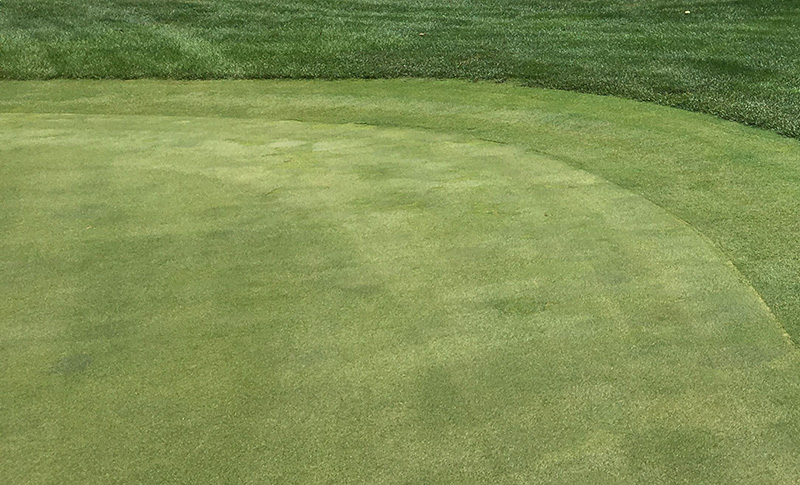
The title of this month’s article is not a proclamation for my favorite football team, the Philadelphia Eagles, for winning the Super Bowl. The Eagles uniform includes green helmets, although I started following the Eagles when they wore white helmets (Google it, young people).
Turfgrass leaves are green because of chlorophyll, a pigment that reflects green light while absorbing light energy to power photosynthesis. Chlorophyll is contained within chloroplasts. Under heat or drought stress, these chloroplasts are protected by cytokinins, thus delaying leaf senescence and helping those leaves to “stay green.” Cytokinin, a plant growth hormone, is biosynthesized in the roots and is also considered a plant biostimulant.
Humic acid is another biostimulant and is used to improve soil properties and plant growth. Humic acids are common components of many plant biostimulant formulations.
Richard Schmidt, Ph.D., is considered the first turfgrass scientist to conduct research on biostimulants and their effects on turfgrass. He earned his doctorate from Penn State but enjoyed a long career at Virginia Tech. He defined “plant biostimulant” as “materials that, in minute quantities, promote plant growth.” Today, the definition of plant biostimulant includes the plant, soil and the rhizosphere.
Recently, research was conducted at Virginia Tech to evaluate humic acid applications on Penn A-4 creeping bentgrass for their effect on cytokinin activity within the plant. Treatments included liquid and granular humic acid products, indole-3-butyric acid (IBA), and water only as the untreated control. All treatments were foliar applied at 0.93 fluid ounce/1,000 square feet (0.29 milliliter/square meter) at 14-day intervals, starting in late May through late August. IBA is an auxin, which is a plant growth hormone. IBA was included because humic acid also exhibits auxin-like activity (auxins promote cell division and elongation and influence root formation).
The putting green was mowed three times per week at 3.2 millimeters (0.125 inch) height-of-cut, irrigated as needed and nitrogen fertilizer applied frequently. Plot size was 9.2 feet × 9.2 feet (2.8 meters × 2.8 meters) with treatments randomized among four replications. In late July, irrigation was stopped to induce drought stress and to measure various plant physiological responses.
The results of this study revealed some insightful trends. All treatments improved turfgrass quality and improved photochemical efficiency (good indicator for photosynthesis function). Also, all humic acid and IBA treatments increased leaf chlorophyll content.
To determine cytokinin content, zeatin riboside — a naturally occurring cytokinin in plants — was measured. The humic acid treatments increased leaf zeatin riboside content. Therefore, the researchers speculated the reduction in leaf senescence and improved turf quality was facilitated by humic acid enhancing leaf zeatin riboside (cytokinin) content. In addition to cytokinin’s anti-senescence function (that stay green effect), it also regulates stomatal openings and gas exchange to prevent oxidative injury during summer stress.
What about the roots? The humic acid treatments also increased leaf indole-3-acetic acid (IAA) content. IAA is an auxin and the most common plant growth hormone and is also associated with root initiation and growth, plant cell division and elongation, and drought tolerance. Overall, the humic acid and IBA treatments increased root length, root surface area, root volume, root biomass and root viability or function. None of the treatments had an effect on root diameter.
This study measured the beneficial response of creeping bentgrass to applications of either liquid or granular humic acid. Humic acids are often utilized to increase the cation exchange capacity of soils, but this study also indicated their positive impact on plant growth hormone metabolism and rooting. However, the prudent turf manager ultimately has to determine if applications of humic acids and other biostimulants are adding value to their overall turfgrass management program.
Source: Zhang, X., M. Goatley, D. McCall, K. Kosiarski and F. Reith. 2022. Humic acids-based biostimulants impact on root viability and hormone metabolism in creeping bentgrass putting greens. International Turfgrass Society Research Journal 14(1):228-294 (https://doi.org/10.1002/its2.37).
Mike Fidanza, Ph.D., is a professor of plant and soil science in the Division of Science, Berks Campus, at Pennsylvania State University in Reading, Pa. He is a 23-year member of GCSAA.